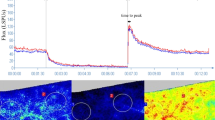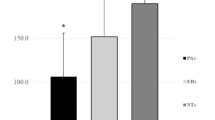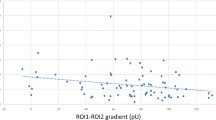Abstract
We lack non-invasive tools for evaluating the coronary and renal microcirculations. Since cutaneous Doppler laser exploration has evidenced impaired cutaneous microvascular responses in coronary artery disease and in impaired renal function, we wanted to find out if there was a link between the impairments in the cutaneous and renal microcirculations. To specify the significance of the rise in the renal resistive index (RI), which is still unclear, we also sought relations between RI and arterial stiffness. We conducted a cross-sectional controlled study in a heterogeneous population including hypertensive patients of various ages with or without a history of cardiovascular disease along with a healthy control group. The cutaneous microcirculation was evaluated by laser Doppler flowmetry of the post-occlusive reactive hyperhemy (PORH) and of the hyperhemy to heat. The renal microcirculation was evaluated by measurement of the RI. Arterial stiffness was evaluated from an ambulatory measurement of the corrected QKD100–60 interval. We included 22 hypertensives and 11 controls of mean age 60.6 vs 40.8 years. In this population, there was a correlation between RI and basal zero to peak flow variation (BZ-PF) (r=−0.42; P=0.02) and a correlation between RI and rest flow to peak flow variation (RF-PF) (r=−0.44; P=0.01). There was also a significant correlation between RI and the corrected QKD100–60 (r=−0.47; P=0.01). The significant correlation between PORH parameters and RI indicates that the functional modifications of the renal and cutaneous microcirculations tend to evolve in parallel during ageing or hypertension. The relation between RI and arterial stiffness shows that RI is a compound index of both renal microvascular impairment and the deterioration of macrovascular mechanics.
This is a preview of subscription content, access via your institution
Access options
Subscribe to this journal
Receive 12 digital issues and online access to articles
$119.00 per year
only $9.92 per issue
Buy this article
- Purchase on Springer Link
- Instant access to full article PDF
Prices may be subject to local taxes which are calculated during checkout





Similar content being viewed by others
References
Norris CS, Barnes RW . Renal artery flow velocity analysis: a sensitive measure of experimental and clinical renovascular resistance. J Surg Res 1984; 36: 230–236.
Veglio F, Provera E, Pinna G, Frascisco M, Rabbia F, Melchio R et al. Renal resistive index after captopril test by echo-Doppler in essential hypertension. Am J Hypertens 1992; 5: 431–436.
Petersen LJ, Petersen JR, Ladefoged SD, Mehlsen J, Jensen HA . The pulsatility index and the resistive index in renal arteries in patients with hypertension and chronic renal failure. Nephrol Dial Transplant 1995; 10: 2060–2064.
Cracowski JL, Minson CT, Salvat-Melis M, Halliwill JR . Methodological issues in the assessment of skin microvascular endothelial function in humans. Trends Pharmacol Sci 2006; 27: 503–508.
Levy BI . Commentary on viewpoint: the human cutaneous circulation as a model of generalized microvascular function. J Appl Physiol 2008; 105: 380; author reply 389.
Rossi M, Carpi A, Di Maria C, Galetta F, Santoro G . Spectral analysis of laser Doppler skin blood flow oscillations in human essential arterial hypertension. Microvasc Res 2006; 72: 34–41.
Carberry PA, Shepherd AM, Johnson JM . Resting and maximal forearm skin blood flows are reduced in hypertension. Hypertension 1992; 20: 349–355.
Farkas K, Kolossvary E, Jarai Z, Nemcsik J, Farsang C . Non-invasive assessment of microvascular endothelial function by laser Doppler flowmetry in patients with essential hypertension. Atherosclerosis 2004; 173: 97–102.
Holowatz LA, Kenney WL . Local ascorbate administration augments NO- and non-NO-dependent reflex cutaneous vasodilation in hypertensive humans. Am J Physiol Heart Circ Physiol 2007; 293: H1090–H1096.
Serne EH, de Jongh RT, Eringa EC, RG IJ, Stehouwer CD . Microvascular dysfunction: a potential pathophysiological role in the metabolic syndrome. Hypertension 2007; 50: 204–211.
Rossi M, Carpi A, Galetta F, Franzoni F, Santoro G . The investigation of skin blood flowmotion: a new approach to study the microcirculatory impairment in vascular diseases? Biomed Pharmacother 2006; 60: 437–442.
Larkin SW, Williams TJ . Evidence for sensory nerve involvement in cutaneous reactive hyperemia in humans. Circ Res 1993; 73: 147–154.
Holowatz LA, Thompson-Torgerson CS, Kenney WL . The human cutaneous circulation as a model of generalized microvascular function. J Appl Physiol 2008; 105: 370–372.
Tedesco MA, Natale F, Mocerino R, Tassinario G, Calabro R . Renal resistive index and cardiovascular organ damage in a large population of hypertensive patients. J Hum Hypertens 2007; 21: 291–296.
Kellogg Jr DL, Liu Y, Kosiba IF, O’Donnell D . Role of nitric oxide in the vascular effects of local warming of the skin in humans. J Appl Physiol 1999; 86: 1185–1190.
Minson CT, Berry LT, Joyner MJ . Nitric oxide and neurally mediated regulation of skin blood flow during local heating. J Appl Physiol 2001; 91: 1619–1626.
Serne EH, Gans RO, ter Maaten JC, Tangelder GJ, Donker AJ, Stehouwer CD . Impaired skin capillary recruitment in essential hypertension is caused by both functional and structural capillary rarefaction. Hypertension 2001; 38: 238–242.
Antonios TF, Singer DR, Markandu ND, Mortimer PS, MacGregor GA . Rarefaction of skin capillaries in borderline essential hypertension suggests an early structural abnormality. Hypertension 1999; 34: 655–658.
Antonios TF . Generalized microvascular disease in essential hypertension: evidence from studies of cutaneous microcirculation. In: Levy, Struijker-Boudier (eds). Role of Micro and Macrocirculation in Target Organ Damage in Diabetes and Hypertension, Chapter 5. Wiley-Blackwell: Chichester, UK, 2009, pp 57–69.
Stewart J, Kohen A, Brouder D, Rahim F, Adler S, Garrick R et al. Noninvasive interrogation of microvasculature for signs of endothelial dysfunction in patients with chronic renal failure. Am J Physiol Heart Circ Physiol 2004; 287: H2687–H2696.
Leoncini G, Martinoli C, Viazzi F, Ravera M, Parodi D, Ratto E et al. Changes in renal resistive index and urinary albumin excretion in hypertensive patients under long-term treatment with lisinopril or nifedipine GITS. Nephron 2002; 90: 169–173.
Kubli S, Waeber B, Dalle-Ave A, Feihl F . Reproducibility of laser Doppler imaging of skin blood flow as a tool to assess endothelial function. J Cardiovasc Pharmacol 2000; 36: 640–648.
Rizzoni D, Porteri E, Boari GE, De Ciuceis C, Sleiman I, Muiesan ML et al. Prognostic significance of small-artery structure in hypertension. Circulation 2003; 108: 2230–2235.
Sax FL, Cannon III RO, Hanson C, Epstein SE . Impaired forearm vasodilator reserve in patients with microvascular angina. Evidence of a generalized disorder of vascular function? N Engl J Med 1987; 317: 1366–1370.
Pedrinelli R, Spessot M, Lorenzoni R, Marraccini P, L’Abbate A, Salvetti A et al. Forearm vasodilatory capacity in patients with syndrome X: a comparison with normal and hypertensive subjects. J Hypertens Suppl 1989; 7: S92–S93.
Jung F, Mrowietz C, Labarrere C, Schuler S, Park JW . Primary cutaneous microangiopathy in heart recipients. Microvasc Res 2001; 62: 154–163.
Shamim-Uzzaman QA, Pfenninger D, Kehrer C, Chakrabarti A, Kacirotti N, Rubenfire M et al. Altered cutaneous microvascular responses to reactive hyperaemia in coronary artery disease: a comparative study with conduit vessel responses. Clin Sci (Lond) 2002; 103: 267–273.
Gosse P, Lasserre R, Minifie C, Lemetayer P . Prognostic value of QKD interval corrected by QRS duration in hypertensive patients. Arch Mal Coeur Vaiss 2005; 98: 747–750.
Gosse P, Braunstein C, Clementy J . Beyond blood pressure measurements: monitoring of the appearance time of Korotkoff sounds. Blood Press Monit 1996; 1: 193–195.
Tublin ME, Tessler FN, Murphy ME . Correlation between renal vascular resistance, pulse pressure, and the resistive index in isolated perfused rabbit kidneys. Radiology 1999; 213: 258–264.
Platt JF, Ellis JH, Rubin JM, DiPietro MA, Sedman AB . Intrarenal arterial Doppler sonography in patients with nonobstructive renal disease: correlation of resistive index with biopsy findings. AJR Am J Roentgenol 1990; 154: 1223–1227.
Hausberg M, Lang D, Barenbrock M, Kosch M . What do Doppler indices of renal perfusion tell us for the evaluation of renal disease? J Hypertens 2005; 23: 1795–1797.
Pontremoli R, Viazzi F, Martinoli C, Ravera M, Nicolella C, Berruti V et al. Increased renal resistive index in patients with essential hypertension: a marker of target organ damage. Nephrol Dial Transplant 1999; 14: 360–365.
Author information
Authors and Affiliations
Corresponding author
Ethics declarations
Competing interests
The authors declare no conflict of interest.
Rights and permissions
About this article
Cite this article
Coulon, P., Constans, J. & Gosse, P. Impairment of skin blood flow during post-occlusive reactive hyperhemy assessed by laser Doppler flowmetry correlates with renal resistive index. J Hum Hypertens 26, 56–63 (2012). https://doi.org/10.1038/jhh.2010.117
Received:
Revised:
Accepted:
Published:
Issue Date:
DOI: https://doi.org/10.1038/jhh.2010.117
Keywords
This article is cited by
-
Assessment of skin microcirculation in primary aldosteronism: impaired microvascular responses compared to essential hypertensives and normotensives
Journal of Human Hypertension (2022)



